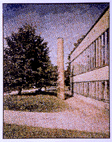Terri
Bird
Australia
Sweden
Jan Svenungsson's
Home Page
Jan Svenungsson
Jan Svenungsson is a Swedish artist born in 1961 and currently based in Berlin. He works in different mediums and often in serial form, making work that takes an interest in the conflict between the lust for chaos and the will for order (the artist creates elaborate and control-obsessed systems that can only achieve chaos in the end). Svenungsson is travelling to Melbourne with the intention of concocting a new project during his journey to be completed in situ and presented in conjunction with the projects 'PSYCHO-MAPPING SCANDINAVIA' and 'PSYCHO-MAPPING EUROPE' Svenungsson referring to his work in an interview states "...I'm interested in the creation of unexpected meaning. In order to trigger the creation of unexpected meaning, one draws up a systematic mechanism with several specific inherent errors, sets it running and looks at what comes out."
Terri Bird
In response to the organizational structure of h. Terri Bird sought a response from Svenungsson to a series of photographs. These photographs focus on the materiality of h. It is the corresponding elements of these exchanged photographs that will be materialized in this exhibition. This exhibition entitled Fictions of being is part of a series, and continues Bird's exploration of material relations. This exploration gives an account of materiality that is always more than merely material, and never simply reduced to a signifying effect. It aims at unsettling the matter-form model in order to imagine other modalities. 'Fiction of being' produces a transposition between two locations. This transposition operates as a hinge that affirms both symmetry and incongruity, as it charts correspondences and modulations.
Jan Svenungsson, Chimney
I,
wood cut, 120 x 120 cm, 1996
Blind dates and other fictions of being
A blind date to meet someone with little prior knowledge about them is an uneasy encounter. It is also a description that in part portrays the organizational structure of h.. h. has initiated a series of exhibitions between strangers, these have solicited varying forms of contact.
I sent a set of photographs to my prospective partner, Jan Svenungsson, made in the location we would later share. I requested, by way of a reply, photographs of the some 'things'. Jan chose to find the corresponding elements for his photographs in the Muse d`'Art Moderne de la Ville de Paris. This was the location of his previous exhibition which preceded ours at h.
Through this transaction I hoped to instigate a passage, an itinerary, between these 'things'. This was not a desire to overcome the distances and spacings that figure in every aspect of the transaction. Neither the multiple distances that separate each of our specific moments of attention to actual things that produced these photographs, nor the distancing inherent in photography between the image recorded and recording surface, or any materialization from these images. On the contrary, this procedure aimed at producing intervals.
In reply to my request, I received a generous response that paid careful attention to framing and context. The exchanged photographs chart an inventory of material relations, which map correspondences and modulations between the two spaces and their locations. These modulations have been materialized for the present exhibition through the transportation of corresponding attributes: peg board on a mobile wall: plywood sheeting bridging down pipe and pier: marble over rendered brick; travertine over plasterboard etc. The positions and proportions of the elements have been contrived from the sent and received photographs respectively.
Instead of regarding the interchange of attributes as simply a material displacement, this maneuver attempts to rethink the connection between the conceptualization of materiality and the materialization of concepts. In these terms, materiality is always more than merely material and never simply reduced to a signifying effect.
The transposition of material attributes activated through the exchange of photographs has manifested a provisional threshold. This threshold is constituted through the movement, or passage, of the interchange. This is a zone of engagement that Jan has also negotiated in order to map our shared location according to his territories and their proliferating disturbances.
The processes of the transaction have rendered perceptible an interface between two practices - an interface that acts as a hinge affirming both symmetry and in congruity.
Terri Bird
